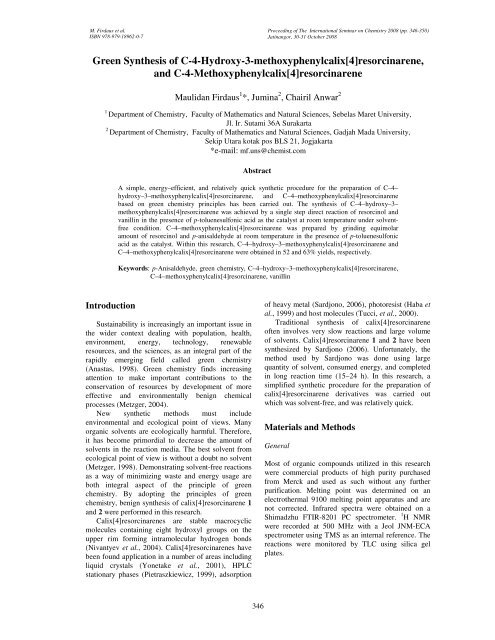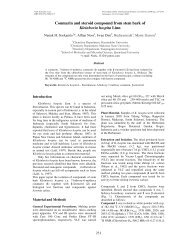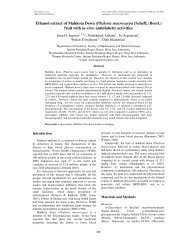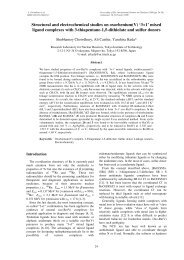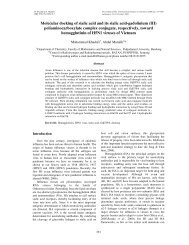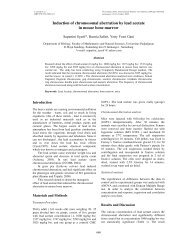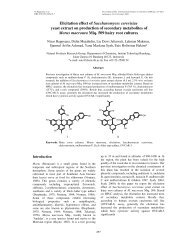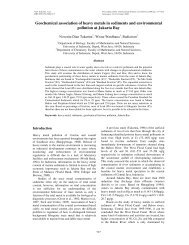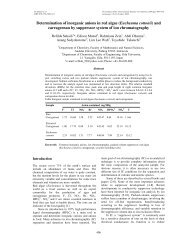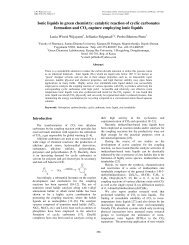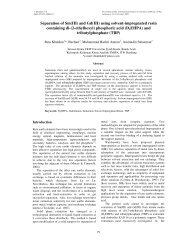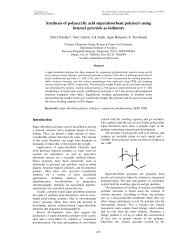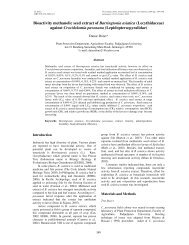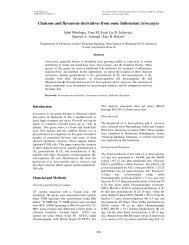Green Synthesis of C-4-Hydroxy-3-methoxyphenylcalix[4 ...
Green Synthesis of C-4-Hydroxy-3-methoxyphenylcalix[4 ...
Green Synthesis of C-4-Hydroxy-3-methoxyphenylcalix[4 ...
- No tags were found...
Create successful ePaper yourself
Turn your PDF publications into a flip-book with our unique Google optimized e-Paper software.
M. Firdaus et al. Proceeding <strong>of</strong> The International Seminar on Chemistry 2008 (pp. 346-350)ISBN 978-979-18962-0-7Jatinangor, 30-31 October 2008<strong>Green</strong> <strong>Synthesis</strong> <strong>of</strong> C-4-<strong>Hydroxy</strong>-3-<strong>methoxyphenylcalix</strong>[4]resorcinarene,and C-4-Methoxyphenylcalix[4]resorcinareneMaulidan Firdaus 1 *, Jumina 2 , Chairil Anwar 21Department <strong>of</strong> Chemistry, Faculty <strong>of</strong> Mathematics and Natural Sciences, Sebelas Maret University,Jl. Ir. Sutami 36A Surakarta2Department <strong>of</strong> Chemistry, Faculty <strong>of</strong> Mathematics and Natural Sciences, Gadjah Mada University,Sekip Utara kotak pos BLS 21, Jogjakarta*e-mail: mf.uns@chemist.comAbstractA simple, energy–efficient, and relatively quick synthetic procedure for the preparation <strong>of</strong> C–4–hydroxy–3–<strong>methoxyphenylcalix</strong>[4]resorcinarene, and C–4–<strong>methoxyphenylcalix</strong>[4]resorcinarenebased on green chemistry principles has been carried out. The synthesis <strong>of</strong> C–4–hydroxy–3–<strong>methoxyphenylcalix</strong>[4]resorcinarene was achieved by a single step direct reaction <strong>of</strong> resorcinol andvanillin in the presence <strong>of</strong> p-toluenesulfonic acid as the catalyst at room temperature under solventfreecondition. C–4–<strong>methoxyphenylcalix</strong>[4]resorcinarene was prepared by grinding equimolaramount <strong>of</strong> resorcinol and p-anisaldehyde at room temperature in the presence <strong>of</strong> p-toluenesulfonicacid as the catalyst. Within this research, C–4–hydroxy–3–<strong>methoxyphenylcalix</strong>[4]resorcinarene andC–4–<strong>methoxyphenylcalix</strong>[4]resorcinarene were obtained in 52 and 63% yields, respectively.Keywords: p-Anisaldehyde, green chemistry, C–4–hydroxy–3–<strong>methoxyphenylcalix</strong>[4]resorcinarene,C–4–<strong>methoxyphenylcalix</strong>[4]resorcinarene, vanillinIntroductionSustainability is increasingly an important issue inthe wider context dealing with population, health,environment, energy, technology, renewableresources, and the sciences, as an integral part <strong>of</strong> therapidly emerging field called green chemistry(Anastas, 1998). <strong>Green</strong> chemistry finds increasingattention to make important contributions to theconservation <strong>of</strong> resources by development <strong>of</strong> moreeffective and environmentally benign chemicalprocesses (Metzger, 2004).New synthetic methods must includeenvironmental and ecological point <strong>of</strong> views. Manyorganic solvents are ecologically harmful. Therefore,it has become primordial to decrease the amount <strong>of</strong>solvents in the reaction media. The best solvent fromecological point <strong>of</strong> view is without a doubt no solvent(Metzger, 1998). Demonstrating solvent-free reactionsas a way <strong>of</strong> minimizing waste and energy usage areboth integral aspect <strong>of</strong> the principle <strong>of</strong> greenchemistry. By adopting the principles <strong>of</strong> greenchemistry, benign synthesis <strong>of</strong> calix[4]resorcinarene 1and 2 were performed in this research.Calix[4]resorcinarenes are stable macrocyclicmolecules containing eight hydroxyl groups on theupper rim forming intramolecular hydrogen bonds(Nivantyev et al., 2004). Calix[4]resorcinarenes havebeen found application in a number <strong>of</strong> areas includingliquid crystals (Yonetake et al., 2001), HPLCstationary phases (Pietraszkiewicz, 1999), adsorption<strong>of</strong> heavy metal (Sardjono, 2006), photoresist (Haba etal., 1999) and host molecules (Tucci, et al., 2000).Traditional synthesis <strong>of</strong> calix[4]resorcinarene<strong>of</strong>ten involves very slow reactions and large volume<strong>of</strong> solvents. Calix[4]resorcinarene 1 and 2 have beensynthesized by Sardjono (2006). Unfortunately, themethod used by Sardjono was done using largequantity <strong>of</strong> solvent, consumed energy, and completedin long reaction time (15–24 h). In this research, asimplified synthetic procedure for the preparation <strong>of</strong>calix[4]resorcinarene derivatives was carried outwhich was solvent-free, and was relatively quick.Materials and MethodsGeneralMost <strong>of</strong> organic compounds utilized in this researchwere commercial products <strong>of</strong> high purity purchasedfrom Merck and used as such without any furtherpurification. Melting point was determined on anelectrothermal 9100 melting point apparatus and arenot corrected. Infrared spectra were obtained on aShimadzhu FTIR-8201 PC spectrometer. 1 H NMRwere recorded at 500 MHz with a Jeol JNM-ECAspectrometer using TMS as an internal reference. Thereactions were monitored by TLC using silica gelplates.346
M. Firdaus et al. Proceeding <strong>of</strong> The International Seminar on Chemistry 2008 (pp. 346-350)Jatinangor, 30-31 October 2008Solvent-free synthesis <strong>of</strong> 1The reaction was done according to the method asdescribed by Roberts et al. (2001). A mixture <strong>of</strong>vanillin (5 mmol), resorcinol (5 mmol), and p-toluenesulfonic acid (0.3 mmol) was added together ina mortar and pestle and ground vigorously. Withinseconds, a viscous paste formed which hardened onfurther grinding. The paste was left to stand for up to1 h, during which time it solidified to yield a red solid.The solid was reground, washed with water to removeany acid, filtered, and the product was recrystallizedwith hot methanol to give pink colored solid 1. m.p.>400 °C. FTIR (KBr) ν max (cm −1 ): 3425 (OH), 1612and 1512 (ArH), 3000 – 2800 and 1373 (CH 3 ), 1427(>CH−), 1033 and 1211 (OCH 3 ). 1 H NMR (500 MHz,DMSO-d 6 ) C 2h isomer δ (ppm): 8.38 (8H, s, OH A ),7.98 (4H, s, OH B ), 5.96 – 6.40 (20H, m, ArH), 5.41(4H, s, >CH−), 3.44 (12H, s, −OCH 3 ). C 4v isomer δ(ppm): 8.47 (8H, s, OH), 7.98 (4H, s, OH), 5.96 –6.40 (20H, m, ArH), 5.58 (4H, s, >CH−), 3.44 (12H,s, −OCH 3 ).Solvent-free synthesis <strong>of</strong> 2This reaction was carried out with the same procedureand condition in mol quantity as in synthesis <strong>of</strong> 1 butvanillin was replaced by p-anisaldehyde. Yield solidm.p. >400 °C. FTIR (KBr) ν max (cm −1 ): 3402 (OH),3001, 1612, and 1512 (ArH), 3000 – 2800 (CH 3 ),1427 (>CH−), 1026 and 1242 (OCH 3 ). 1 H NMR (500MHz, DMSO-d 6 ) C 2h isomer δ (ppm): 8.43 (8H, s,OH), 5.74 – 6.60 (24H, m, ArH), 5.44 (4H, s, >CH−),3.61 (12H, s, −OCH 3 ). C 4v isomer δ (ppm): 8.52 (8H,s, OH), 5.74 – 6.60 (20H, m, ArH), 5.57 (4H, s,>CH−), 3.70 (12H, s, −OCH 3 ).Results and DiscussionC–4–hydroxy–3–<strong>methoxyphenylcalix</strong>[4]resorcinarene1 and C–4–<strong>methoxyphenylcalix</strong>[4]resorcinarene 2have been prepared by a single step direct synthesisunder solvent free condition. The reaction wasachieved by simply grinding together equimolarquantities <strong>of</strong> starting materials in the presence <strong>of</strong> p-toluenesulfonic acid as the catalyst. The methodologyis simple, energy-efficient, and relatively quick. Thismethod is significantly faster than solvent-basedmethod traditionally employed in the synthesis <strong>of</strong> 1and 2 as previously reported by Sardjono (2006). Thereaction scheme for the formation <strong>of</strong> 1 and 2 ispresented in Figure 1.Solvent-free synthesis <strong>of</strong> 1Solvent-free synthesis <strong>of</strong> calix[4]resorcinarene 1from vanillin and resorcinol gave pink colored solid in52% yield having melting point >400 °C. Regardingthe theoretical atom economy, this reaction has highatom economy (93%). Unfortunately, the experimentalatom economy is only 48%. Although theexperimental atom economy is not as high as thetheoretical atom economy, this procedure is still incorridor <strong>of</strong> the green chemistry principles. Thereduced reaction time, elimination <strong>of</strong> energy neededfor heating and/or cooling, minimum quantity <strong>of</strong>catalyst, elimination <strong>of</strong> solvent and subsequent wasteare all important factors in complying with theprinciples <strong>of</strong> green chemistry.Figure 1 <strong>Synthesis</strong> <strong>of</strong> calix[4]resorcinarene 1 and 2FTIR spectrum <strong>of</strong> compound 1 shows the hydroxyl(-OH) stretching as a broad absorption at 3425.3 cm −1 .Strong absorptions at 1612.4 and 1512.1 cm −1 indicatean aromatic group. Absorption band at 3000 – 2800cm -1 together with absorption at 1373.2 cm −1 expressthe existence <strong>of</strong> Csp 3 -H from a methyl group. Theabsorption <strong>of</strong> the methine group appears at 1427.2cm −1 . Absorptions at 1033.1 cm −1 and 1211.2 cm −1indicate a C–O–C bond <strong>of</strong> methoxy bonded inunsaturated group (Sharma, 2002). There is noaldehyde absorption band <strong>of</strong> the starting material(vanillin) appeared in the spectrum. This is theevidence that the reaction had taken place. All <strong>of</strong> thefunctional groups appeared in the spectrum (Figure 2)are consistent to the structure <strong>of</strong> C–4–hydroxy–3–methoxyphenyl calix[4]resorcinarene.% TransmittanceWavenumber (cm −1 )Figure 2 FTIR Spectrum <strong>of</strong> Compound 1347
M. Firdaus et al. Proceeding <strong>of</strong> The International Seminar on Chemistry 2008 (pp. 346-350)Jatinangor, 30-31 October 20081 H NMR spectrum <strong>of</strong> calix[4]resorcinarene 1shows 5 signal groups depicting 5 different types <strong>of</strong>protons (Figure 3). Signal <strong>of</strong> proton E is overlappingwith proton H 2 O signal. Therefore, it is difficult to beinterpreted and analyzed. However, it can still bepredicted that the signal at δ = 3.44 ppm is fromOCH 3 protons. The existence <strong>of</strong> aromatic protons areshown at δ = 5.96 – 6.40 ppm. Signals at δ = 5.41 –5.58 ppm are coming from methine bridge protons.The resonance <strong>of</strong> hydroxyl group protons occur at δ =7.98 – 8.47 ppm. All <strong>of</strong> the protons in the spectrumare very appropriate to the structure <strong>of</strong> C–4–hydroxy–3–methoxy-phenylcalix[4]resorcinarene.ABCDEChemical shift (ppm)C–4–hydroxy–3–<strong>methoxyphenylcalix</strong>[4]resorcinarene.Solvent-free synthesis <strong>of</strong> 2The synthesis <strong>of</strong> C–4–<strong>methoxyphenylcalix</strong>[4]resorcinarene2 was achieved using the same methodologyas described in the synthesis <strong>of</strong> 1 section. The startingmaterial used in previous section, vanillin, wasreplaced by p-anisaldehyde. The product was solid in63% yield having melting point >400 °C.Regarding FTIR spectrum (Figure 5) analysis,there is no aldehyde absorption band <strong>of</strong> the startingmaterial (p-anisaldehyde) appeared in the spectrum.This is the evidence that the reaction had taken place.FTIR spectrum <strong>of</strong> compound 1 shows –OH stretchingabsorption at 3402.2 cm −1 . Strong absorptions at1612.4 and 1512.1 cm −1 together with absorption at3001 cm -1 indicate an aromatic group. Absorptionband at 3000 – 2800 cm −1 express the existence <strong>of</strong>Csp 3 -H from a methyl group. Absorptions at 1026.1and 1242.1 cm −1 indicate a C–O–C bond <strong>of</strong> methoxygroup (Sharma, 2002). Thus, the FTIR spectrum <strong>of</strong>the synthesized product indicates that the compoundcontains an aromatic, a hydroxyl, and a methoxygroup, which is in full agreement withcalix[4]resorcinarene 2 structure.Figure 3 1 H NMR Spectrum <strong>of</strong> Compound 1Calix[4]resorcinarenes commonly occur in twoisomeric forms, namely the cis-cis-cis (rccc) or C 4vand the cis-trans-trans (rctt) or C 2h isomers, which aredistinguishable by comparison <strong>of</strong> 1 H NMR spectra.The C 4v or ‘crown’ isomer and the C 2h or ‘chair’isomer is illustrated schematically in Figure 4(Tunstad et al., 1989 and Roberts et al., 2001). In thisresearch, the ratio <strong>of</strong> C 4v : C 2h isomer is 1 : 5.% TransmittanceHOOHHOHO OH OH OHOHC 4v isomerWavenumber (cm −1 )RRRRFigure 5 FTIR Spectrum <strong>of</strong> Compound 2C 2h isomerHOHORHOHOROHROHRFigure 4 Schematic <strong>of</strong> C 4v and C 2h isomersBased on FTIR and 1 H NMR spectral, it can beconcluded that the product obtained from solvent-freereaction between resorcinol and vanillin in thepresence <strong>of</strong> p-toluenesulfonic acid as the catalyst isOHOH1 H NMR spectrum <strong>of</strong> the synthesized product(Figure 6) shows signal at δ = 3.44 ppm from -OCH 3protons. Signals at δ = 5.44 – 5.57 ppm are comingfrom methine bridge protons. The existence <strong>of</strong>aromatic protons are shown at δ = 5.75 – 6.60 ppm.The hydroxyl group protons resonate at δ = 8.43 –8.52 ppm. All <strong>of</strong> the protons in the spectrum are veryappropriate to C–4–methoxyphenyl calix[4]resorcinarenestructure.348
M. Firdaus et al. Proceeding <strong>of</strong> The International Seminar on Chemistry 2008 (pp. 346-350)Jatinangor, 30-31 October 2008Table 1 Comparison synthetic procedures for the synthesis <strong>of</strong> 1 and 2CompoundCalix[4]resorcinarene 1Calix[4]resorcinarene 2<strong>Green</strong> Methodology- Solvent-free- Grinding at room temperature- Complete in 15 minutes- Yield 52%- Solvent-free- Grinding at room temperature- Complete in 15 minutes- Yield 63%ProcedureSolution Phase Methodology- Large volume <strong>of</strong> solvent (~ 50 mL ethanol)- Refluxing at 80°C for 15 hours- Yield 98% (Sardjono, 2006)- Large volume <strong>of</strong> solvent (~ 50 mL ethanol)- Refluxing at 80°C for 24 hours- Yield 90% (Sardjono, 2006)AHOBAOH*involved large volume <strong>of</strong> solvent, consumed moreenergy, and needed long reaction time.A*B CB BB BOCH 3 DBC4DConclusionsBy demonstrating the principles <strong>of</strong> greenchemistry, C-4-hydroxy-3-<strong>methoxyphenylcalix</strong>[4]resorcinarene and C-4-<strong>methoxyphenylcalix</strong>[4]resorcinarene have been synthesized at roomtemperature under solvent-free condition. Thismethodology is simple, high-yielding, and energyefficientwhich represents a viable alternative totraditional solution phase methodologyChemical shift (ppm)AcknowledgementsFigure 6 1 H NMR Spectrum <strong>of</strong> Compound 2The result <strong>of</strong> isomeric distribution calculation <strong>of</strong>the product is different with compound 1. The isomerratio <strong>of</strong> compound 1 is C 4v : C 2h = 1 : 5. ‘Chair’isomer (C 2h symmetry) is more dominant than ‘crown’isomer (C 4v symmetry) in the calix[4]resorcinarene(1). In contrast, compound (2) with ratio <strong>of</strong> C 4v : C 2hsymmetry = 2 : 1 indicates that crown isomer is in alarger quantity rather than chair isomer. This indicatesthat each aldehyde has different characteristicsbetween one to another.Based on the results <strong>of</strong> FTIR and 1 H NMRanalyses, it can be concluded that the synthesizedproduct from solvent-free reaction between resorcinoland p-anisaldehyde in the presence <strong>of</strong> p-toluenesulfonic acid as the catalyst is C–4–<strong>methoxyphenylcalix</strong>[4]resorcinarene.In comparison with conventional methodology(Table 1), this greener procedure is more feasible tobe done than solution phase methodology as describedby (Sardjono, 2006). Both <strong>of</strong> the methods used tosynthesis 1 and 2 in solution phase methodologyThe financial support from IndonesianDirectorate General <strong>of</strong> Higher Education in the form<strong>of</strong> BPPS fellowship is greatly appreciated.ReferencesAnastas, P. T., & J. C. Warner. 1998. <strong>Green</strong>Chemistry: Theory and Practice. OxfordUniversity Press, Oxford.Haba, O., K. Haga, & M. Ueda. 1999. A NewPhotoresist Based on Calix[4]resorcinarenesDendrimer. Chem. Mater. 11:427–432.Metzger, J. O. 1998. Solvent-Free Organic <strong>Synthesis</strong>,Angew. Chem. Int. Ed., 37:2975–2978.Metzger, J. O. & M. Eissen. 2004. Concepts on theContribution <strong>of</strong> Chemistry to a SustainableDevelopment. Renewable Raw Materials, C. R.Chimie. 7:1–13.Nifantyev, E.E., V.I. Maslennikova, W.D. Habicher,O.S. Serkova, & T.A. Guzova. 2004, New Aspectsin The Chemistry <strong>of</strong> PerphosphorylatedCalix[4]resorcinarenes, Arkivoc, xii:23–37.Pietraszkiewicz, M., Kozbial & M. Pietraszkiewicz.1998. Pol. J. Chem. 72:886.349
M. Firdaus et al. Proceeding <strong>of</strong> The International Seminar on Chemistry 2008 (pp. 346-350)Jatinangor, 30-31 October 2008Roberts, B. A., G. W. V. Cave, C. L. Raston, & J. L.Scott. 2001. Solvent-free <strong>Synthesis</strong> <strong>of</strong>Calix[4]resorcinarenes, <strong>Green</strong> Chemistry. 3:280–284.Sardjono, R. E. 2006. Sintesis dan PenggunaanTetramer Siklis Seri Kaliksresorsinarena,Alkoksikaliksarena, dan Alkenilkaliksarena untukAdsorpsi Kation Logam Berat, PhD Dissertation,Program Pascasarjana Universitas Gadjah Mada,Jogjakarta.Sharma, Y. R. 2002. Elementary OrganicSpectroscopy: Principles and ChemicalApplications, S. Chand and Company Ltd., NewDelhi.Tucci, F. C., A. R. Renslo, D. M. Rudkevich & J.Rebek. 2000. Angew. Chem., Int. Ed. 39:1076.Tunstad, L.M., J.A. Tucker, E. Daicanale, J. Weiser,J.A. Bryant, J.C. Shermant, R.C. Helgeson, C.B.Knobler, & D.J. Cram. 1989. Host-GuestComplexation 48. Octol Building Blocks forCavitands and Carcerands, J. Org. Chem.54:1305–1312.Yonetake, K., T. Nakayama & M. Ueda. 2001. J.Mater. Chem. 11:761.350


